The essence of a polarizing filter is very simple - such a filter is capable of delay reflected polarized light... For example, reflected light from water, glass, etc. can be blocked, thereby making water and glass transparent. But the filter's capabilities are not limited to this.
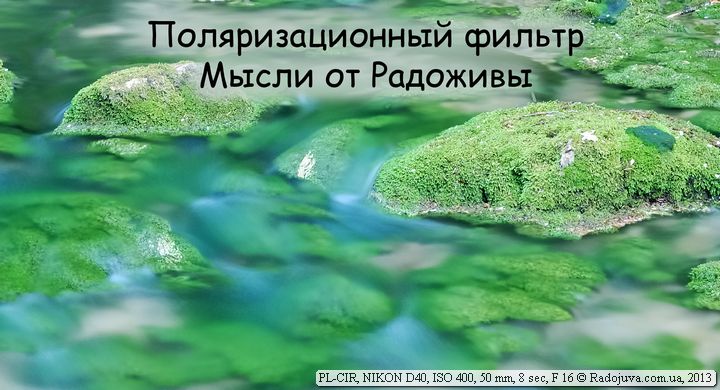
Polarizing filter
The polarizing filter itself consists of two parts - movable and fixed. The fixed part of the filter is screwed into the thread of the lens filter. The movable part can rotate 360 degrees freely. Through front rotation polarization filter is the adjustment of the filter for a certain type of polarized light, and at the same time with its delay by such a filter. Due to the fact that the filter is connected with the rotation of the front part, such a filter is best used on lenses with an internal focusing system. If the front lens of the lens rotates with the lens at the lens, this introduces inconvenience when working with a polarizing filter.
The polarizing filter can be wound onto protective filter. You can wear a lens cap on the polarizing filter, or you can add some other filter. The only thing, the more filters are screwed into each other, the greater the probability of getting vignetting at the corners of the image. Some polarizing filters may not have threads on their front.
That pick up a polarizing filter for the lens, you must know the diameter of the thread of the lens under the filter. For example, a standard lens for the Nikon CZK Nikon 18-55mm f / 3.5-5.6G VR has a diameter of 52mm, and it needs a polarizing filter with a diameter of 52mm. This may seem ridiculous, but many people can’t choose a filter because they don’t know if it fits their lens. The effect of the polarizing filter can be seen on any lens.
Some features:
- The polarizing filter does not transmit reflected polarized light. This is the main property of the filter; it can be used in a large number of situations. For example, using a polarizing filter, you can remove glare from the water (light reflected from the water) and photograph the bottom.
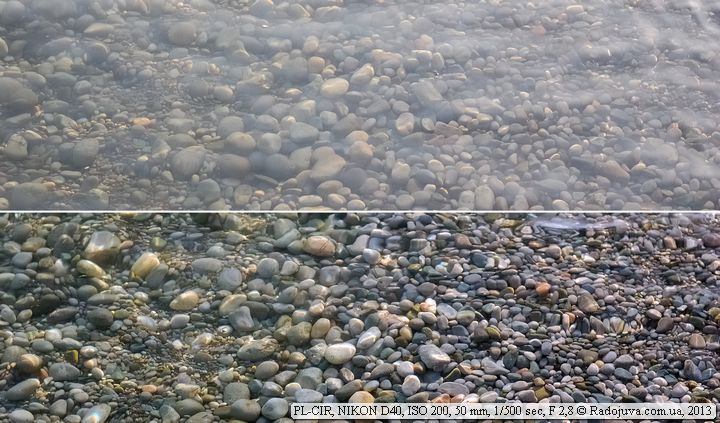
Sea bottom with different position of PL-CIR filter
- The filter also removes reflections of the blue sky from the earth, grass, leaves. The sky adds extra cool tones (blue, cyan) to the photo. When using a polarizing filter, everything acquires a warmer and more natural color. Lung color changes can be traced to other examples.

Different colors at different positions of the polarizing filter
- When using a polarizing filter for subject shooting, it is possible to reduce glare on the subject.
- Such a filter allows you to achieve a pleasant blue sky with white clouds. Due to the small particles in the air, the light of the sky is partly polarized. In general, the effect appears more saturated colors.

Sky when using a polarizing filter. The filter allows you to align the luminosity of the sky and provides a slightly different color rendering of greenery.
- In general, a polarizing filter works like a neutral filter, passing less light. For example, with a polarizing filter you can easily shoot on a bright dayusing aperture F / 1.4 with a shutter speed of 1/4000 s and ISO 100 will be enough for correct exposure without overexposure. Many people overlook the fact that, in any case, a polarizing filter reduces the luminous flux. In low light conditions, I recommend shooting the polarizer so that the lens can receive more light. A combination of ND and PL filters is very interesting to use.
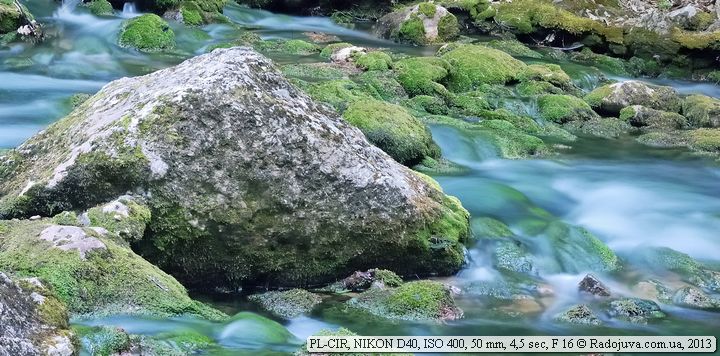
Long excerpt. When using a polarizing filter, you can significantly increase the shutter speed, which can serve, for example, for the effect of smoothness of water in photographs.
- If you turn the circular polarizing filter back to front, you can get a neutral filter, when you rotate around its axis, you can shift such a filter white balance in warm and cold tones, while the polarizing filter stops blocking polarized light.
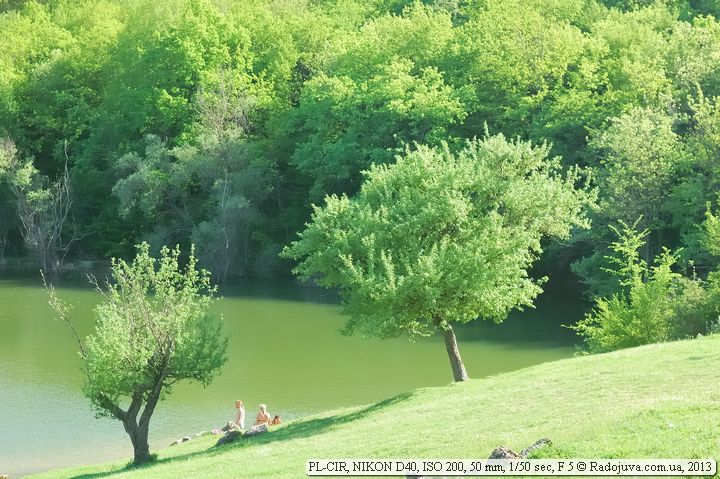
The color of grass and leaves when using a polarizing filter on a bright sunny day
- When using polarization filters with a linear type of polarization on modern digital SLR cameras, serious measurement errors can occur exposure and focus accuracy. It is treated by manually adjusting the focus and exposure. But when using filters with circular polarization some special problems with measurement exposure and focus accuracy I don’t observe.
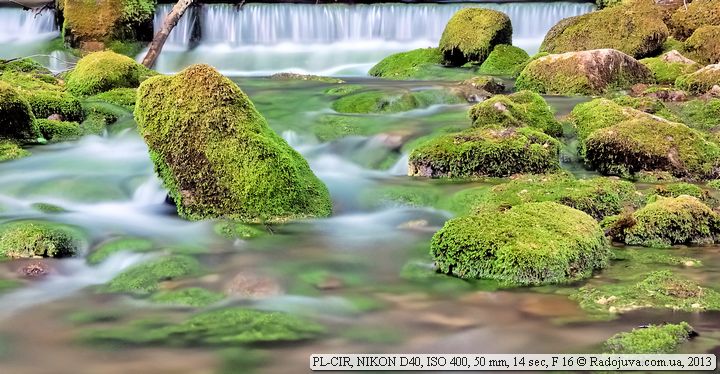
Water clarity by filtering glare from the filter
The operation of the polarizing filter is easy to see using a conventional computer monitor. The display light is always polarized in a certain plane, and with the help of a polarizing filter it is easy to remove it as shown in the example below:
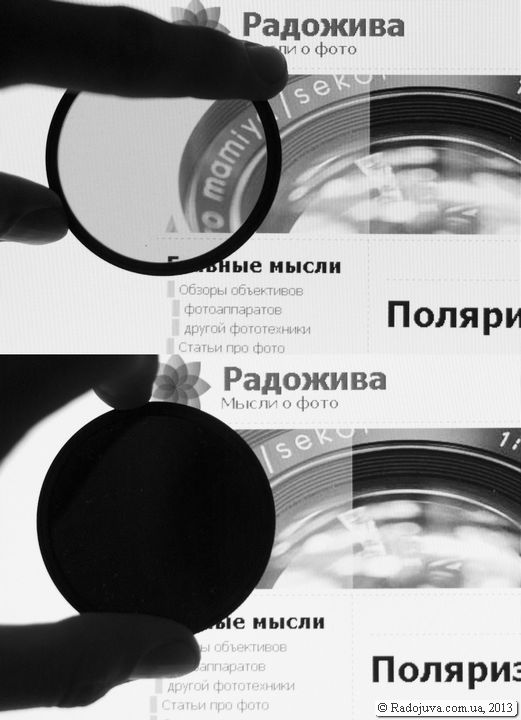
An example of a polarizing filter
The polarizing filters themselves are of two types - with linear and circular polarization. In general, circularly polarized filters are better. I don't want to repeat myself, this has already been written many times, for example here.
An abbreviated polarizing filter is called a 'PL filter' or simply 'polarizing'. A good polarizer is not cheap. As usual, the more expensive the filter, the better it is. However, inexpensive polarizers are also suitable for amateur photography. For example, I am using Hoya 58mm PL-CIR Made in Japan. My colleagues say that very high quality polarics are B + W and Rodenstock, but very often the difference between the cheaper Hoya, Marumi, Kenko is very difficult to feel.
Conclusions:
A polarizing filter is an interesting and useful device for achieving unique effects in photographs. Such a filter is an indispensable thing for shooting landscapes, outdoor work in sunlight, etc.
Comments on this post do not require registration. Anyone can leave a comment.
Material prepared Arkady Shapoval.

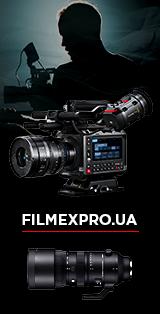
Happy holiday! Thanks for the beautiful photos!
What, on the contrary, are scenes not worth shooting with a wrap-around polar?
Sometimes glare in the shadows can emphasize the texture of the surface, and removing the glare from the polar can turn the surface into a dark spot. It also sometimes makes the sky unrealistically dark. And so very useful, even in portraiture.
Since it does not allow part of the light to pass through, there is no need for ultra-short shutter speeds in bright sunshine, this is another plus and how protective also works.
For myself, I concluded that without a polarizing filter in the heat it is very difficult to get a blue sky in photographs. I always carry it with me in the summer.
I will allow myself another small addition about the polar. It also helps a lot when filming an interview on a bright day, softening the shadows and reducing the intensity of the overexposed areas on the person’s face.
However, polarik is not recommended for use in dynamic shooting, for example on steadicam or the shoulder system due to the constant microscopic (and not very :)) tilt of the horizon and the polarization plane displacements resulting from this. Roughly speaking, the camera will be forced to constantly adjust the exposure, which in some cases can give ugly fluctuations in brightness.
Very valuable observation. On fotik the same, but more time, and adjusting the photo is easier than video.
Arkady, he took 44 ND2-400 onto Helios, when it rotates one part relative to another, it changes transparency (the usual property of polarized gratings). so to reduce the effect of reflections it turns out you need to twist the lower part and the upper? because there is linear polarization on both glasses. In general, I took it to take pictures in the sun with a flash and an open aperture, because at 2.8 the shutter speed is usually 1200 or higher, and the flash in slow sync (no fast) works up to 200. And you have to shoot without a flash with black dips in the eyes and shadows under with your nose. And now there is a filter, but I never tried it, I forgot.
I have it called Fotga Fader ND. I tried it today. Yes you really need to twist for the polarization effect. In the ND400 position, exposure metering does not work at all. It is very convenient to set suppression across the sky - it turns not white, but blue. I took 2 pictures from the balcony of poplars. With and without filter. With the filter, there is no sun glare from young foliage.
Wrote Conclusions
PL filter, unlike others, has a limited life, the PL layer itself tends to fade in bright light and loses its properties, 5-6 years of intensive use and buy a new one, so we removed it in a bag.
Thank you!
Good afternoon. I found and bought a 52mm Polarik for 65 hryvnia at Aukro, it works fine. Why pay more? ))))
Polarik for 250 rubles, I suspect, will not be very well enlightened, as a result, you will lose in contrast, especially under difficult lighting conditions
How does enlightenment affect contrast?
What is enlightenment?
how to name a person who gives advice himself not understanding in a question?
About enlightenment, it’s written a little here http://m42-adapter.in.ua/multiprosvetlennaya-linza-na-perehodnike-m42-nikon-zachem-ona-nuzhna/
You can't buy a polarik for 65 UAH, but I can recommend GreenL - China, but it performs its functions http://infoto.com.ua/filter/cpl
I ordered a filter for 300r from China. I did not notice anything like it.
I bought filters in China - at dkh.kom, at dinodirect - and protective (UV) and polarics. Yes, it is cheaper than Hoya, but glare with the back and side. So the price is the price, and the quality is the quality.
I agree with you, in most cases the cheapest filter can be almost indistinguishable from the picture in good shooting conditions. And those differences that will be visible are not critical if the photos are not intended for experienced connoisseurs of photography. Cheap filters can cause problems if you are critical of vignetting, color cast, but even in expensive ones, it is different, when light sources enter the lens, they can cause light glare, ghosting. If a cheap polaric is illuminated from the side, it will glow, an expensive one will remain dark, which will be reflected in the picture. Also the lifespan of the cheaper ones, maybe less, so I wouldn't recommend it at all. Among Kenko, Marumi, Hoya, etc. there are different price lines and if you take only by the name - this does not guarantee you a good quality of the polarizing filter. So in the Pro series Kenko can be better than Hoya, and on average, Marumi can outrun both.
How to find out these price ranges?
By name) For example, HOYA Standart, HMC, PRO1D, HD, FUSION series. These ruler names must appear in the filter markings.
Last week I bought the Hoya TEK Pol-Circ polarizer. The first tests were not impressive, I expected more. But I think everything will come with practice.))))
The fact is that there can be a polarik (if linear) should I set correctly?
Linear no matter which side to put. And circular - it is one-sided. That is, it is a linear one with an additional filter between it and the lens, which removes polarization - after all, everything is already filtered.
pl is a linear polarizer.
cpl- circular, (actually elliptical with a different ellipse at different wavelengths)
the circular filter creates circular polarization but in this case it doesn’t matter
lol?
Has anyone taken a portrait photo in nature with a polar?
Denis, I tried it, just against the background of the sky - everything is ok, it does not spoil the skin, adds a little contrast.
Vladislav, thank you!)) That's exactly for the skin it was interesting and it was. It's just that they told me in the store that the polarik is not at all suitable for portrait photos. But which manufacturer is not a secret?
It’s they who are talking nonsense, I once did not dare to shoot a canon 100mm, sigma 180mm makro portrait, because everywhere they wrote that macro spoils the skin very much and strengthens all the imperfections, and as a result fifty dollars sharps the face more by 2,8 than weaving and sigma.
Arkady,
4. ... the light of the sky from a part is ... - "partly" - together
7. ... It is manual to be treated ... - in this case, the word should be. no soft sign
With respect.
Good day Arkady!
For a long time I know about the polar, well, there wasn’t enough time to sit down to read, compare, and then they took it on you and presented it to me on a plate. BRAVO!!! finally sat down read, figured out, became interested!
And such a question: I have two lenses for the Hoya HMC UV (O) and Hoya HMC UV (C) filter. In what sequence (which is the first on the lens) are they installed on the lens in a polarized group? and do they need to be installed in a group (well, in general)? How are you doing?
It is better to leave one polar. I take off the protective, put the polarizer. If you wear, then the lens is protective, and the protective polar.
Good afternoon, Arkady
How can one explain the appearance of pink shades in a pure blue sky when using a circular polar (the sun is 90 degrees to the right of the shooting direction). D90 ISO 200 camera, no histogram light?
The filter burned out. Its burnout is manifested in the form of pinkishness in bright areas.
I completely agree with Arkady. I also put one polar. It turns out better than putting a polarik on a protective one.
And which manufacturer would you recommend?
who can say good sunpak cirkular polarizer or vice versa
I bought Marumi DHG Circular PL (D) such a question, can anyone know what the triangle on the rim means?
There are such suspicions that it should be set relative to the sun =))
I always use it myself constantly spinning to the desired result.
Hello Arkady. Tell me please, can the metering be mistaken when using a polarizer? (D7000 camera)
Arkady, but the filters that are shown in the photo with the Tair-11 A lens (they are included with it) in paragraph 8, how to use, or where to read about them?
Like it found, but not readable))) https://radojuva.com.ua/2012/03/review-mc-zm-5ca-500mm-f8/
Arkady, if there will be an article about the Cokin system, it will be more tricky, if you do, you should take the system and filter (nd4, nd8, P121 ...) to a figure for landscape photography.
please tell me whether it is possible to wear a cokin system with a gradient filter or any other on the installed polarik. (combination of polarik then gradient). Probably more interested in the moment of installing the adapter ring from cokin to polarik.
The same interests)
Hello. There is a 67mm polarizing filter. Is it possible to use an adapter ring for a 67-77mm filter if the lens diameter is larger, i.e. 77mm? Nikon D7000, a lens for a full frame.
Tell me. Will it fit Nikon D5100 from 18-105 Hoya TEK Pol-Circ. 67mm and Marumi Cross Screen 67mm will it focus normally, etc. ?????????? thanks in advance)